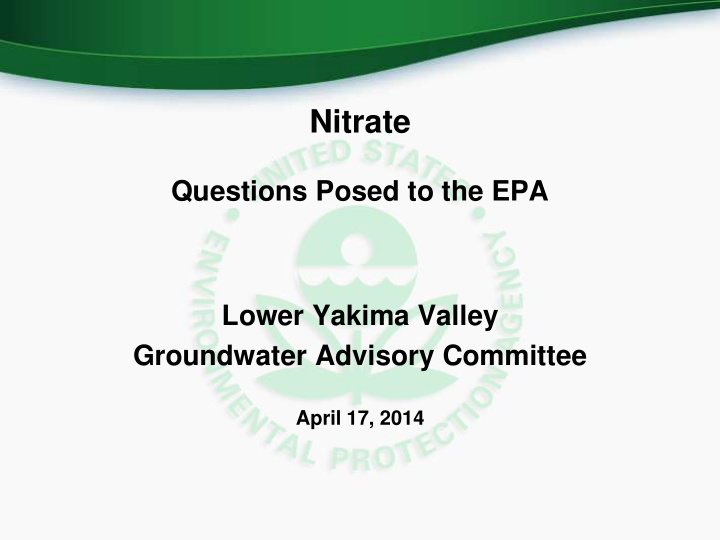



Nitrate Questions Posed to the EPA Lower Yakima Valley Groundwater Advisory Committee April 17, 2014
Questions Posed to the EPA How was 10ppm Decided to be the Threshold for Safe Drinking Water? What are the Health Risks of Drinking Water containing Nitrate at Concentrations Greater than the MCL?
How was 10ppm Decided to be the Threshold for Safe Drinking Water? Nitrate National Primary Drinking Water Regulation National Primary Drinking Water Regulation of Nitrate Proposed November 13, 1985 Reproposed May 22, 1989 Promulgated January 30, 1991 Nitrate Maximum Contaminant Level Goal (MCLG) Non-enforceable, based solely on possible health risks, lifetime of exposure, adequate margin of safety Nitrate 10mg/l (as N), Nitrate + Nitrite 10 mg/l (as N) Nitrate Maximum Contaminant Level (MCL) S et as close to the MCLG as “feasible” Nitrate 10mg/l (as N), Nitrate + Nitrite 10 mg/l (as N)
How was 10ppm Decided to be the Threshold for Safe Drinking Water? Basis for the Nitrate MCLG and MCL Survey of epidemiologic studies of infant methemoglobinemia in populations exposed to nitrate contaminated drinking water Infants are most sensitive to the acutely toxic effects of nitrate Greater water consumption relative to body weight Increased percent conversion of nitrate to nitrite Greater sensitivity of hemoglobin Critical Effect: Early clinical signs of methemoglobinemia in formula fed infants ages 0-3 months 214 cases with available drinking water nitrate level data Study found no adverse effects were observed below 10 mg nitrate/l (as N)
How was 10ppm Decided to be the Threshold for Safe Drinking Water? Basis for the Nitrate MCLG and MCL Other Considerations Carcinogenicity: no cancer classification available Developmental or reproductive effects: inadequate data No Uncertainty Factor Due to intraspecies variability, an uncertainty factor of 10 is normally applied to ensure adequate protection of the most sensitive population members In this case there was no uncertainty factor applied MCLG was designed to protect the most sensitive population Supporting studies included a large number of subjects 10 mg/l (as N) standard in effect for decades, no cases of methemoglobinemia below that level
How was 10ppm Decided to be the Threshold for Safe Drinking Water? Results of Nitrate Health Assessment Reviews since Regulation National Academy of Sciences (1995) Assessment of nitrite and nitrate found no new data to warrant a review of the Reference Dose or cancer classification EPA Six-Year Review (2002) Literature search found no new studies to warrant a review of the Reference Dose or cancer classification EPA Six-Year Review (2010) Health effects review identified new information on developmental, thyroid and carcinogenic effects, new assessment may be warranted
What are the Health Risks of Drinking Water containing Nitrate at Concentrations Greater than the MCL? EPA Integrated Risk Information System (IRIS) http://www.epa.gov/iris Cases of methemoglobinemia reported at 11-20 mg/l nitrate (as N) are usually associated with concomitant exposure to bacteriologically contaminated water or excess intake of nitrate from other sources Most cases of infant methemoglobinemia are associated with exposure to nitrate in drinking water used to prepare infants' formula at levels >20 mg/l of nitrate (as N)
What are the Health Risks of Drinking Water containing Nitrate at Concentrations Greater than the MCL? U.S. Standard compared with Other Standards World Health Organization (WHO) Guideline of 11 mg/l as N (EPA’s MCL is 10 mg/l as N) based on methemoglobinemia in infants from short term exposure WHO Guideline also expressed as 50 mg/l as nitrate Water can be used if the concentration is between 11 mg/l - 22 mg/l as N (also expressed as 50 mg/l and 100 mg/l as nitrate ) if the water is microbiologically safe, with increased vigilance by medical authorities Recommends water with nitrate >22 mg/l as N (also expressed as 100mg/l as nitrate ) not be used for bottle-fed infants
What are the Health Risks of Drinking Water containing Nitrate at Concentrations Greater than the MCL? U.S. Standard compared with Other Standards Health Canada Committee on Drinking Water proposed a maximum acceptable concentration (December 2012) of 45 mg/l as nitrate (equivalent to EPA’s MCL of 10 mg/l as N), based on methemoglobinemia in infants Also considered thyroid effects, estimated lifetime cancer risk of 6.5 x10 -6 using worst-case assumptions at nitrate levels of 10 mg/l as N
Questions Contact Information: Fredianne Gray U.S. EPA Region 10 gray.fredianne@epa.gov (206) 553-6387
Recommend
More recommend